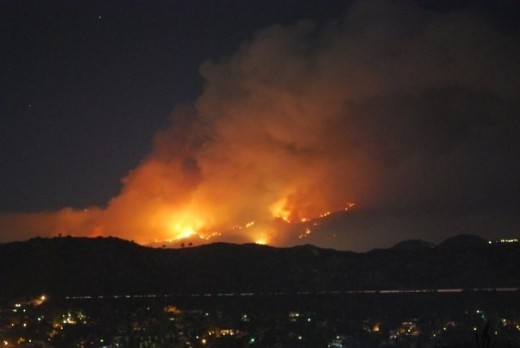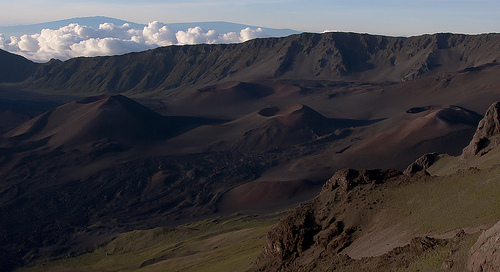- HubPages»
- Travel and Places»
- Visiting North America»
- United States
A Local's Guide to Hawaii Volcanoes
Kilauea Lava Flow
Hawaii is made up of six shield volcanoes. They are Kilauea (active), Mauna Kea (dormant), Mauna Loa (active), Hu’alalai (dormant), Kohala (extinct), and Haleakala (extinct). Five of these volcanoes make up the Big Island (Hawai’i), while Haleakala makes up Maui. Tourists come from all over the world to see Hawaii’s beaches and most of them discover that the volcanoes are just as interesting.
On Hawaii’s volcanoes, you can star gaze, zip line, watch a breath-taking sunrise, and even walk right up to the lava! This Hawaiian volcano guide is useful for visitors that want to have an exciting trip and to those who just want to learn more about Hawaii’s volcanoes.
Ancient Hawaiians believed that the volcanoes were sacred places that the gods had built for themselves. Pele, the god of war and fire, is known to reside in Kilauea, the most active volcano in Hawaii. Mauna Kea, the tallest mountain in the world (if measured from below sea level) and was known as the most sacred mountain.


Kilauea
Kilauea is pronounced, “kill-a-way-ah”. In Hawaiian, “Kilauea” means spewing because it is constantly spewing lava.
One of the most active volcanoes in the world can be found on the Big Island of Hawaii. Kilauea is located on the South Eastern side of the island. Kilauea is unique in that although it is actively pouring lava down the coast, visitors are allowed to walk right up to the flow.
Visitors enter through the Volcanoes National Park to see the lava flow. Within the park, you can walk to the edge of smoking craters or take a 5-mile hike through one. You can also visit two visitor centers that will educate you on the geology, seismology and wildlife on the island.

Pu'u O'o Cone
The lava flows from Pu’u O’o cone, which could be considered as a subsidiary volcano on the peak of Kilauea. This cone has been continually erupting since 1983, but the volcano itself has been erupting since Polynesians came to the island in 300 CE. They believed that Pele, the goddess of war and fire made her home in the Pu’u O’o cone, where she continually pours her sadness and anger down the coast.
Fun Fact About Kilauea
In 2010, a man who lived in Kalapana, an area on the southeastern slope of Kilauea, began to worry about others moving into the area. These foreigners built telephone lines and roads to support their large homes. Unlike the man, these people did not have respect for Hawaiian mythology. The man who was there originally lived in a small shack with no electricity. Every morning, he would take an offering up the mountain and serve it to Pele.
The day after the foreigners moved into their new subdivision, the mountain erupted and began to flow toward them (a path the lava had never flowed before). All of their homes were destroyed—covered in a basalt blanket. The flow had covered all of the homes in its way except it split at one point and reunited after passing by the respectful man’s shack. His home was the only thing standing in the path of the lava. From this day on, people have become more aware of Pele and are not as quick to dismiss the legend.

Mauna Kea
Mauna Kea is pronounced, “mow-nah kay-uh”. In Hawaiian, Mauna Kea means “White Mountain” because there is usually snow on the summit.
Mauna Kea is the tallest volcano in the world (when measured from the ocean floor). It is 13,796 feet tall and has telescopes from all over the world for astronomical research. There are a total of twelve telescopes on Mauna Kea’s summit.

List of Telescopes at Mauna Kea
Name
| Short Name
| Owners
|
|---|---|---|
Caltech Submillimeter Obervatory
| CSO
| Caltech
|
Canada-France-Hawaii Telescope
| CFHT
| Canada, France, University of Hawaii
|
Gemini North Telescope
| USA, UK, Canada, Chile, Australia, Argentina, Brazil
| |
Infrared Telescope Facility
| IRTF
| NASA
|
James Clerk Maxwell Telescope
| JCMT
| UK, Canada, Netherlands
|
Subaru Telescope
| National Astronomical Observatory of Japan
| |
Sub-Millimeter Array
| SMA
| Taiwan, USA
|
United Kingdom Telescope
| UKIRT
| UK
|
University of Hawaii 88-inch Telescope
| UH88
| University of Hawaii
|
University of Hawaii 36-inch
| Hoku Kea
| University of Hawaii
|
Very Long Baseline Array
| USA
| |
W. M. Keck Observatory
| California Association for Research in Astronomy
|

Fun Fact About Mauna Kea
Many people do not think of snow when they picture Hawaii, but it snows on Mauna Kea. Locals visit Mauna Kea and pack snow into their cars to bring down the mountain.
Mauna Kea's Unique Climates
Mauna Kea was the most sacred of all of the island’s volcanoes to Native Hawaiians. Only the ali’i (chiefs) were allowed to go up Mauna Kea’s slopes. These ali’i would have meetings on the summit to discuss important matters. When foreigners came to Hawaii, they did not obey the Hawaiian law of Kapu (the forbidden and sacred); they used the slopes of Mauna Kea to raise cattle and other livestock.
Because of the animals, the mountain that was once covered in forests now has three different climates: an alpine climate at its summit, a Sophora chrysophylla–Myoporum sandwicense (or māmane–naio) forest on the upper slopes, and an Acacia koa–Metrosideros polymorpha (or koa–ʻōhiʻa) forest at the base of the mountain.

Mauna Loa
Mauna Loa is pronounced, “mow-na low-uh”. In Hawaiian, Mauna Loa means long mountain because it is the longest mountain in the world.
Mauna Loa spans 120 km from the Kona-side to the Hilo-side. Mauna Loa is so long, that it covers over a third of the Big Island.
In 1843, the first recorded eruption occurred. Since then, it has erupted 33 times and is expected to soon. The last eruption was in 1984, when it covered some of the damage done by Hualalai in the early 1800s.
Researchers have been analyzing the mountain as it appears to be swelling, meaning that sometime in the near future, it may erupt again.


Haleakala
Haleakala is pronounced "hah-lay-ah-kah-lah". In Hawaiian, Halekala means house of the sun because from the summit, you can see both the sunrise and sunset.
Haleakala is located on Maui, the island closest to the Big Island (Hawai'i). The volcano is now extinct and many tourists like to hike up the sides to watch the sun rise and fall.
Haleakala once connected the Big Island to Maui, but with uplift comes erosion and now, a powerful wind channel (the Alanui Channel) has submerged the two island's connection below sea level.

Fun Fact About Haleakala
An Ancient Hawaiian legend takes place on the summit of Haleakala. The story goes like this:
Maui lived with his mother, Hina, who made kapa (a cloth made out of bark). During the day, she would lay the kapa out to dry, but it would never dry by the time that the sun would set in the west. One day, she showed Maui her frustration and wished that the sun would stay out long enough to dry her kapa.
Maui tore the husk off of some coconuts and wrapped them so that they made a lasso. He hiked up the slopes of Haleakala and threw his lasso into the sky just as the sun rose over the horizon. The lasso wrapped around the sun and the sun yelled, "Why are you doing this? Let me go!"
Maui stood tall and held onto the lasso with all of his might. "Please, sun, stay out long enough for my mother's kapa to dry," he begged.
After much discussion, the sun and Maui came to a compromise. The sun would move more slowly for six months, then race across the sky as usual for the next six months.


Kohala
Kohala is pronounced "ko-hah-lah".
Kohala is the only extinct volcano on the Big Island because it is the oldest volcano in Hawaii. Kohala is known for its beautiful ranch country and also for the gorgeous cliffs that surround it. The volcano makes up the north-side of the Big Island and is home to King Kamehameha's birth place.
Kohala was used by Ancient Hawaiians as a place to grow crops. Later, foreigners made great sugar cane plantations that still exist on the volcanoes slopes.


Hu'alalai is pronounced "who-ah-lah-lie".
Hu'alalai is a dormant volcano that rests on the west-side of the Big Island in between Mauna Kea and Mauna Loa. As the third most-active volcano, Hualalai has erupted numerous times during history. It's damage can be seen on the sides of the Queen Ka'ahumanu Highway spanning from Kailua-Kona to Kawaihae. The sides of the road are covered in basalt that erupted from Hualalai between 1790 and 1801. People now use dead coral (white) to write in the rocks.
In 1929, a large earthquake occurred below Hualalai that made scientists assume that the volcano would erupt again within the next 100 years.
Map of Hawaii's Volcanoes
Lo'ihi is a new volcano forming on the south-side of the Big Island.








